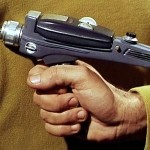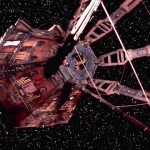Science Fiction has traditionally done a pretty good job of making us feel sad about not living in the future. We get a taste of some of the wondrous technology that might be available to our distant descendants, and then almost immediately are hurled back into our normal boring lives, which are full of toil, inconvenient menial tasks, and wasps. So much for progress.
But what we often fail to realise is that many modern technologies have actually gone far beyond anything Science Fiction was able to conjure up until comparatively recently. This often leads to the well-documented phenomenon of zeerust, in which the “futuristic” devices of SF past become so hopelessly dated that they appear amusingly quaint in hindsight. A particularly good example of this comes in the form of older depictions of “supercomputers” using tape reels and vacuum tubes. However, what may surprise you, gentle reader, is that some anachronisms that are still reasonably common in Science Fiction have escaped scrutiny almost entirely in the popular consciousness. Here are a few of our favourites.
1. Guns which fire bullets are the norm because they’re much more efficient than anything else
Almost every space-borne sci-fi show has some kind of energy-based weapon as the standard mechanism of combat between hostiles. In fact, lasers, phasers, and plasma guns are such an ingrained aspect of the genre in the eyes of some that it becomes slightly odd when they’re omitted (as in the remake of Battlestar Galactica). Some people remain disappointed that we haven’t abandoned traditional guns in favour of the more psychedelic option, but there’s a very good reason we haven’t.
First of all, the technology to create weapons-grade lasers has existed for some time, but it is ludicrously inefficient and has a bad habit of setting the air around the weapon’s firing line on fire. Likewise, “plasma” has the disadvantage of being essentially very hot gas, and being about as aimable and shootable as steam. Meanwhile, projectile-based guns are easy and cheap to make, and extremely good at killing things. As more knowledge of how next-gen weapons work trickles down, this facet of the sci-fi trope library is beginning to see less and less of the light of day, with railguns, coil guns, and other mass-accelerator type devices taking their place.
2. While our spacecraft may look worse, they are a lot better at actually being spacecraft
Discerning casual viewers of space missions will have noted that many of the things humans put into orbit or beyond are by no means easy on the eye. By comparison, many aircraft, along with the huge number of spaceships seen in TV and movie Science Fiction are sleek, smooth-edged things that are exceptionally pretty to look at. The very good reason behind this is that the sleek, smooth, aerodynamic models of fiction would be almost entirely useless outside of the atmosphere.
When you have an atmosphere around, it’s obviously to your advantage to make vehicles that are designed to move through it efficiently, hence the concept of “aerodynamic” design. However, out in space, where there is no atmosphere to steer against and nothing much at all producing friction, aerodynamics isn’t likely to get you very far. Craft like the moon lander look so ungainly and ugly precisely because they’ve been designed to be efficiently propelled by rockets, which are the only motive force currently available to us. So future spacecraft are likely to be more ‘Red Dwarf’ and less ‘Starship Enterprise’. The sole exceptions are space shuttles, which have been designed with some basic aerodynamic considerations in mind because they need to be able to fly through the atmosphere in order to land.
3. Our handheld computers are much better than most iconic fictional examples
Admittedly, this one feels like a bit of a cheat, since laptops, tablets and ultrabooks are now produced by dozens of manufacturers and a lot of these devices are a recent phenomenon. It’s difficult to blame shows like Star Trek for not anticipating them. But even our most recent science fiction forays have been prone to misrepresenting the power of handheld devices: They are either depicted as specialist equipment or bulky and inelegant. In reality, a properly configured tablet or smartphone can actually harness the same technology as their sedentary equivalents.
With a little bit of work, you can even double-head your computer setup in such a way that you can achieve the same effect seen with the handheld computer in this scene at the beginning of Avatar (ironically released within a few months of the first true tablets becoming commercially available). Our touchscreens are also sensitive and advanced enough to replicate effects seen in films like Minority Report, but we’ve done one better than the movies again in that we haven’t stapled them to a wall, so it’s actually possible to use them while sitting down, and without Tom’s ‘special gloves’.
Of course, this doesn’t mean that the dreamers of Hollywood don’t influence real world design. Would we have had the ‘clam-shell’ mobile phone without the original Star Trek communicator, or the iPad without Star Trek’s PADD? Maybe… But I can’t help thinking that people that designed those products must have been influenced by the TV shows and movies they saw in their youth. You only have to look at NASA to see that it did have some effect. After all, what was the name of the first space shuttle?.. Enterprise.



